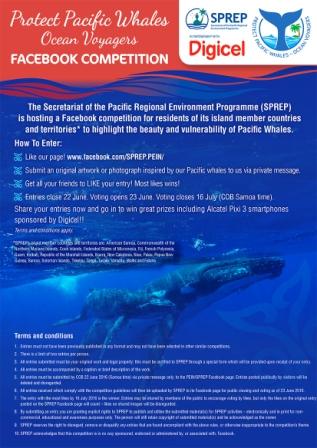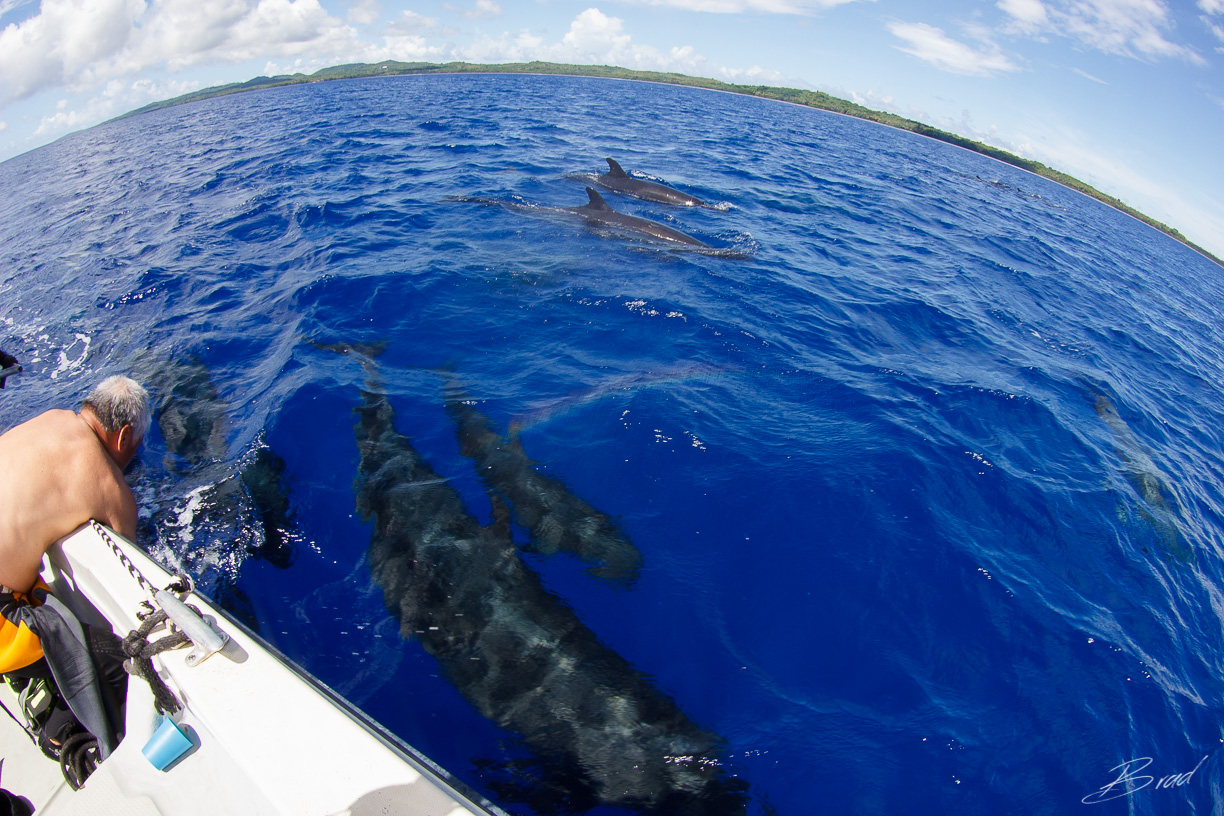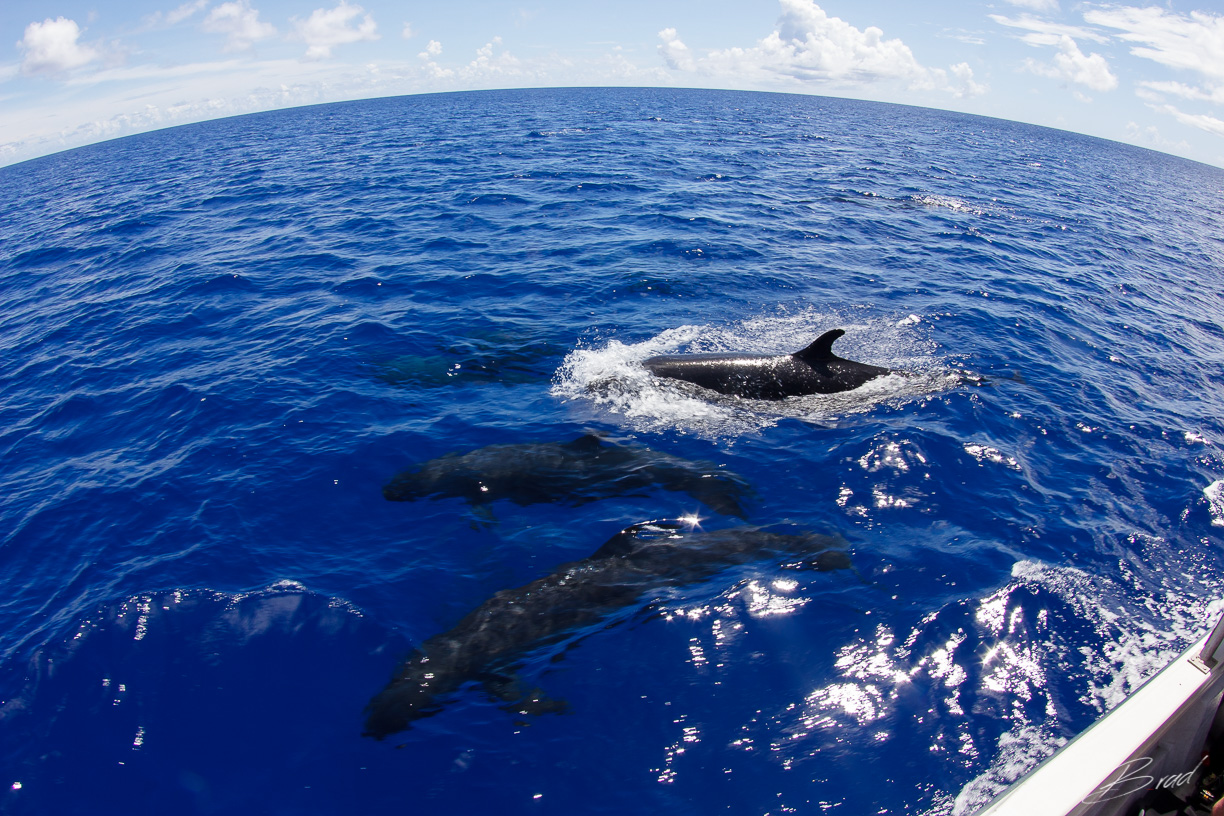Tracking Humpback Whales
Joint Media Release: IRD and WWF FR - Scientists from the IRD, WWF and Opération Cétacés (a whale research NGO) returned well pleased from their second MARACAS program, tracking humpback whales on board the "Amborella". This time, they were able to implant some satellite beacons. Whales can now be followed on Internet in real time.
Started in 2016, the WHERE Project researches humpback whale distribution and habitat over New Caledonia's maritime zone. The project pays particular attention to the farther reaches of the Coral Sea Nature Park. This park is one of the largest marine reserves in the World. It was created by the New Caledonian Government in 2014.
The first two field work programs of this research (MARACAS 1 and 2) have just been completed. They were managed by teams from IRD, WWF and Opération Cétacés, supported by "Amborella"'s crew. "Amborella" is the New Caledonian Government's oceanography research vessel.
The MARACAS 1 program ran from the 22nd August to the 4th September in the West Coral Sea. The aim was to take a cross-section of the enormous Chesterfield and Bellona reef complexes extending over 300km. Over the two week mission duration, a few pods of whales were seen and studied. Despite the handicap of windy weather, it is still surprising there were so few sightings. This area offered the best whaling in the 19th century, and the field work took place at the height of the mating season. But team members have refrained from coming to hasty conclusions. It seems that there have been fewer sightings overall in Southern Hemisphere mating sites in 2016. Further field work in 2017 will no doubt yield additional information.
The MARACAS 2 program has just been completed. It took place over three days around Walpole Island on board "Amborella". This time, very favourable weather conditions enabled the collection of much information about humpback whales in this part of the Coral Sea Nature Park. Approximately thirty individuals were sighted. Amongst them were a number of mothers with young. As during the first program, photos and skin samples will enable researchers to learn more about links between groups of animals within the Park.
Satellite beacons were successfully implanted on four adult whales. The data received from the beacons is not limited to tracking their movements, but will also indicate how the animals relate to their habitat. In addition to geo-location, the beacons will transmit data recorded during dives, providing information about behaviour.
Members of the public are welcome to follow the whales' movements on the New Caledonia Government's map explorer at http://urlz.fr/4aer.
This month at SPREP: ‘Noise, ship strike and other emerging threats to whales in Oceania’ Seminar
By Micheal Donoghue, Threatened and Migratory Species Adviser
“As part of SPREP’s Protect Pacific Whales campaign, we were pleased to welcome Dr Simon Childerhouse to the SPREP campus earlier this month, to discuss two of the emerging threats to whales in the Pacific islands – noise in the ocean and the potential for deep sea mining to have adverse impacts on whales.
We were also pleased to welcome colleagues from Samoa’s Ministry of Natural Resources and Environment, the Ministry of Agriculture and Fisheries and the United Nations Development Program, as well as SPREP staff.
Dr Childerhouse is now employed by Blue Planet Marine, but has previously been Marine Mammal Scientist for both the New Zealand Department of Conservation and the Australian Antarctic Division.
His talk was based on a presentation to an international conference on deep sea mining in 2014 that he co-authored, and drew heavily on his experience with two recent applications in New Zealand – to mine for ironsands off the North Island’s west coast, and for rock phosphate on the Chatham Rise. Both these applications were declined, partly because of the lack of understanding about the likely impacts of mining operations, and in particular the extent and the impacts on marine life of the sediment plume that would be generated.
Dr Childerhouse also drew attention to the potential adverse impacts on whales and dolphins of the airgun arrays that are used in seismic surveys to identify hydrocarbon and other deposits under the seabed, and the other assorted noises from pumps and other machinery that can be generated once a mining operation gets underway. He noted that the noise from seismic surveys caused by far the greatest concern, and could be detected by whales tens or even hundreds of kilometres away.
He stressed that while there were ways to mitigate the impacts of seismic surveys, he was not aware of any Pacific island country that had in place any Code of Conduct or similar guidelines to achieve this. He said that the NZ Code of Conduct for minimising the impact on marine mammals from seismic surveys, published in 2013 was well regarded internationally with high standards of protection and mitigation. Over the last three years in NZ, mitigation actions carried out in line with the Code had added only 6% to the total survey time.
He recommended that SPREP consider disseminating the NZ Code to Member countries whose EEZs were being explored through the use of seismic surveys.
The afternoon was rounded off by a screening of the documentary Sonic Sea, which explored in greater detail the impacts of noise on whales and other marine life.”
![]() Whale Quote of the Week
Whale Quote of the Week
"I think that we reject the evidence that our world is changing because we are still, as that wonderfully wise biologist E. O. Wilson reminded us, tribal carnivores. We are programmed by our inheritance to see other living things as mainly something to eat, and we care more about our national tribe than anything else. We will even give our lives for it and are quite ready to kill other humans in the cruellest of ways for the good of our tribe. We still find alien the concept that we and the rest of life, from bacteria to whales, are parts of the much larger and diverse entity, the living Earth."
Author: James E. Lovelock
![]() Did You Know?
Did You Know?
Not surprisingly, the blue whale boasts the largest heart in the world, which is about the size of a VW Beetle and weighs up to 1000 pounds. The aorta attached to this super-sized heart is big enough for a human child to crawl through.
![]() Whale Quote of the Week
Whale Quote of the Week
"I walk outside and scream at the top of my lungs, and it maybe travels two blocks. A whale unleashes his cry, and it travels hundreds or even thousands of miles. Every whale in the ocean will at one time or another run into that song. And I figure whales probably don't edit. If they think it, they say it...Whale talk is the truth, and in a very short period of time, if you're a whale, you know exactly what it is to be you."
Author: Chris Crutcher
![]() Did You Know?
Did You Know?
The tusk or horn of the male narwhal is actually an oversized canine tooth. The tooth pierces the left lip, growing throughout life up to 10 feet long. This fancy oversized tooth is jam-packed with nerve endings and grows in a left-handed helix spiral. Oddly, about 15% of female narwhals also have tusks. Some of the first narwhal teeth (or tusks) to reach Europe were touted as being the horns of the mythical unicorn
![]()
Have you entered our Protect Pacific Whales Facebook Competition?
The Secretariat of the Pacific Regional Environment Programme (SPREP) is hosting a Facebook competition in partnership with Digicel for residents of its island member countries and territories* to highlight the beauty and vulnerability of Pacific Whales.
1. Like our Facebook page! www.facebook.com/SPREP.PEIN/
2. Submit an original artwork or photograph inspired by our Pacific whales to us via private message
3. Get all your friends to LIKE your entry! Most likes wins!
Entries close 22 June. Voting opens 23 June. Voting closes 16 July (COB Samoa time).
Send your entries to us now and go in to win great prizes including Alcatel Pixi 3 smartphones sponsored by Digicel!!
*SPREP's island member countries and territories are: American Samoa, Commonwealth of the Northern Mariana Islands, Cook Islands, Federated States of Micronesia, Fiji, French Polynesia, Guam, Kiribati, Republic of the Marshall Islands, Nauru, New Caledonia, Niue, Palau, Papua New Guinea, Samoa, Solomon Islands, Tokelau, Tonga

Terms and conditions
1. Entries must not have been previously published in any format and may not have been selected in other similar competitions.
2. There is a limit of two entries per person.
3. All entries submitted must be your original work and legal property; this must be certified to SPREP through a special form which will be provided upon receipt of your entry.
4. All entries must be accompanied by a caption or brief description of the work.
5. All entries must be submitted by COB 22 June 2016 (Samoa time) via private message only, to the PEIN/SPREP Facebook page. Entries posted publically by visitors will be deleted and disregarded.
6. All entries received which comply with the competition guidelines will then be uploaded by SPREP to its Facebook page for public viewing and voting as of 23 June 2016.
7. The entry with the most likes by 16 July 2016 is the winner. Entries may be shared by members of the public to encourage voting by likes, but only the likes on the original entry posted on the SPREP Facebook page will count – likes on shared images will be disregarded.
8. By submitting an entry you are granting explicit rights to SPREP to publish and utilise the submitted material(s) for SPREP activities – electronically and in print for non-commercial, educational and awareness purposes only. The person will still retain copyright of submitted material(s) and be acknowledged as the owner.
9. SPREP reserves the right to disregard, remove or disqualify any entries that are found uncompliant with the above rules, or otherwise inappropriate to the competition's theme.
10. SPREP acknowledges that this competition is in no way sponsored, endorsed or administered by, or associated with, Facebook.
![]() Whale quote of the week
Whale quote of the week
"We humans, as species, are interested in communication with extraterrestrial intelligence. Would not a good beginning be improved communication with terrestral intelligence, with other human beings of different cultures and languages, with the great apes, with the dolphines, but particularly with those intelligent masters of the deep, the great whales?"
Author: Carl Sagan
![]()
Did you know...
The closest living relative to cetaceans (whales and dolphins) are hippos
![]() Share your whale observation in New Caledonia with scientists !
Share your whale observation in New Caledonia with scientists !
20 Mai 2016
Did you observe a whale or marine mammals in New Caledonia ? You should let these scientists know !
You can share an observation, a picture, a GPS position on this website.
Please help us to identify New Caledonian marine mammals by reporting your observations. This initiative is part of the Protect Pacific Whales campaign.
Many of you are observing whales every days. Your observations will help us census marime mammals and identify their areas. TPlease try to take a picture of the animla while respecting the whale-watching guidelines and note your geographic position. These observation reports will contribute to the study of all marine mammals species in New Caledonia: dolphins, whales, dugong.
![]() PODCAST- Pacific's great whales under threat from climate change, pollution and deep sea mining
PODCAST- Pacific's great whales under threat from climate change, pollution and deep sea mining
- 20 April 2016
 The Secretariat of the Pacific Regional Environment Programme has launched a two-year campaign to protect whales in the Pacific. While their numbers have recovered from the brink of extinction after two million were killed by whaling fleets last century, now they're under threat from entanglement, pollution, deep sea mining, and climate change. Michael Donoghue, SPREP's Threatened and Migratory Species Adviser, says recognising these threats is especially important, as whatever damage is done to whale populations is likely to also affect people living in the Pacific.
The Secretariat of the Pacific Regional Environment Programme has launched a two-year campaign to protect whales in the Pacific. While their numbers have recovered from the brink of extinction after two million were killed by whaling fleets last century, now they're under threat from entanglement, pollution, deep sea mining, and climate change. Michael Donoghue, SPREP's Threatened and Migratory Species Adviser, says recognising these threats is especially important, as whatever damage is done to whale populations is likely to also affect people living in the Pacific.
Presenter: Richard Ewart (Radio Australia)
Speaker: Mike Donoghue, Threatened & Mirgratory Species Adviser, pictured
Listen:![]()
![]() Launch of the Protect Pacific Whales campaign at SPREP
Launch of the Protect Pacific Whales campaign at SPREP
15 April, 2016
A two year Pacific regional campaign to 'Protect Pacific Whales – Ocean Voyagers' was launched in Samoa yesterday.
Read more on this article.
![]() Whale quote of the week
Whale quote of the week
"Do whales know each other's names? Can they recognise each other as individuals by sounds alone? We have cut the whales off from themselves. Creatures that communicated for tens of millions of years have now effectively been silenced." ― Carl Sagan, Cosmos

Credit-Niue Tourism Office
![]() Did you know ?
Did you know ?
The largest animal to ever grace our planet, living or extinct, is the blue whale. Blue whales have tipped the scales at 140 tons and reached 100 feet (30.5 meters). The blue whale tongue alone can weigh as much as an elephant.
![]() Cetaceans of Yap: a natural heritage awaiting discovery
Cetaceans of Yap: a natural heritage awaiting discovery
14 March 2016
Located in the far Western Pacific, and part of the Federated States of Micronesia, the island of Yap (or Wa´ab), actually a grouping of islands encircled by a coral ring which hosts the capital of the State with the same name, is a stronghold of both nature and culture in the region. Better known for its resident population of manta rays, Yap also boasts resident and regularly visiting cetaceans, which despite being easily seen very close to the outer reef margin have yet to be properly studied by scientists.

Most striking to the visitor and with great potential for tourism is a resident pod of short-finned pilot whales (Globicephala macrorhynchus), which in calm wind days is easily approachable by boats and allow snorkelers to share the water with them, even if at a distance, as water visibility allows for viewing the animals without directly interfering with them.
Spinner dolphins (Stenella longirostris) are also residents and easily seen in large pods, approaching the dive boats on their rides around the island toward several dive sites which are visited daily.

Orcas (Orcinus orca) are a rare sight, but at least one transient family seems to regularly visit the islands, likely taking advantage of the wealth of large-sized fish prey in its vicinity. They have been seen in November and February but also known to come around the islands during summer.
Research on the cetaceans of Yap, in a region where little is known about this particular group of marine wildlife, is an open field for anyone willing to undertake it and engage local supporters such as Manta Ray Bay Resort & Yap Divers, which is willing to provide help with the logistics for fieldwork there.
Text provided by José Truda Palazzo, Jr; photos by Brad Holland, Manta Ray Bay Resort - Yap Divers